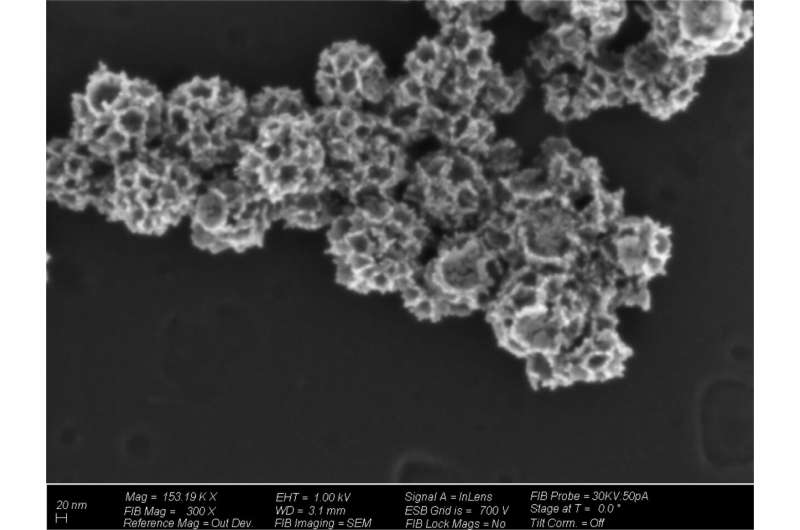This article has been reviewed according to Science X's editorial process and policies. Editors have highlighted the following attributes while ensuring the content's credibility:
fact-checked
peer-reviewed publication
trusted source
proofread
Going for gold: Nanotech design opens door to new cancer treatments

To develop cancer drugs, researchers often have to make tough trade-offs. Most drugs potent enough to kill tumors also cause unpleasant side effects—and may end up doing more harm than good. Now, researchers and clinicians at Stevens Institute of Technology and Hackensack Meridian Health have developed a new drug delivery system that uses gold nanoparticles to deliver drugs to tumors with remarkable precision—while dramatically reducing the potential for systemic side-effects.
In a paper published in ACS Applied Materials & Interfaces, the team describes the ability to pack and seal drugs into a porous gold nano-framework, then apply a hyaluronic acid coating on the outer surface of the nanoparticle to further seal the drug inside. The result is an extremely stable particle that only gives up its payload when it binds to hyaluronic acid receptors on the surface of a lymphoma tumor.
"Gold is very stable, so it's the perfect material for drug delivery," explained Hongjun Wang, a professor of biomedical engineering and the director of the Semcer Center for Healthcare Innovation at Stevens who led the research together with Johannes Zarkzweski, a physician at Hackensack. "Using this approach, we're able to deliver drugs much more precisely and get much better clinical outcomes."
Because the drugs are delivered selectively, with minimal leakage into the bloodstream, significantly lower quantities of drugs can be used to treat a tumor, reducing the risk of toxic side effects. In animal studies, the team found no sign of toxicity and no detectable levels of drugs in the bloodstream, despite the fact that the chemicals they were delivering ordinarily cause detectable toxicity in 50% of subjects.
The gold nanoparticles continue to circulate in the bloodstream much longer than free-floating drug molecules, meaning that patients who currently receive daily treatments might be able to switch to weekly or bi-weekly regimens. In animal trials, lymphoma tumors also responded markedly better to the targeted drug delivery than to non-targeted treatments, suggesting that new treatment protocols could be developed to improve outcomes in human cancer patients.
Using gold as a delivery system opens the door to other clinical applications, including the use of tumor-seeking gold nanoparticles as a contrast agent to enable more precise imaging. The particles can also be heated by shining harmless light energy into the patient's body, effectively "cooking" tumors from within. They can also be calibrated to deliver their pharmaceutical payload only when triggered by incoming light, providing additional control over how and when drugs are delivered.
The nanoparticles can be loaded with drugs very quickly and efficiently, using inexpensive and scalable chemical processes—a fact that should help offset the expense of using gold to deliver pharmaceuticals. "Cost is always a concern, of course," said Wang. "But this is a simple methodology, and we think the benefits speak for themselves."
While the current study focused on validating the use of gold nanoparticle drug delivery systems in animals, Wang hopes to see the approach developed for testing in human cancer patients. "We've shown this works in animals—now we need to show it's safe in people, too," he explained. Pharmaceutical companies are already showing interest in the approach, and the FDA has already approved the use of gold in other clinical applications, he noted.
In the meantime, Wang added, the primary research goal is to develop more sophisticated outer pore sealants that rely on antibodies to target other, harder-to-treat tumors with similarly high specificity.
"Our ultimate goal is to use this approach to target multiple myeloma and other cancers that are currently not curable," said Wang. "I hope we can complete the foundational research and push this forward to clinical trials soon."
More information: Manpreet Bariana et al, Targeted Lymphoma Therapy Using a Gold Nanoframework-Based Drug Delivery System, ACS Applied Materials & Interfaces (2023). DOI: 10.1021/acsami.2c17214
Journal information: ACS Applied Materials and Interfaces
Provided by Stevens Institute of Technology



















